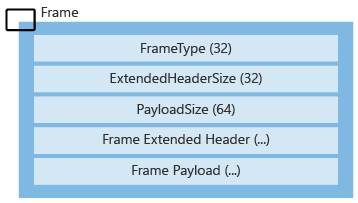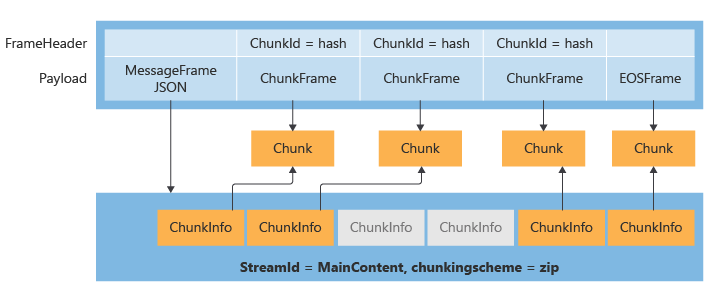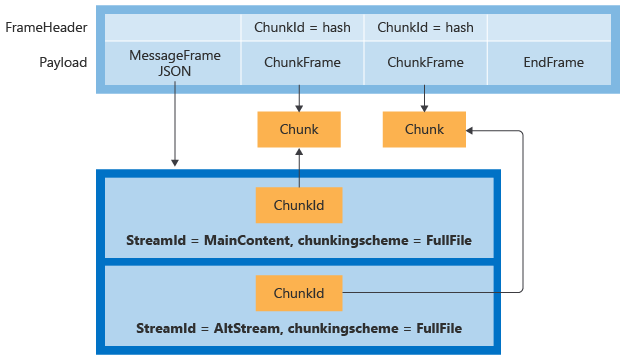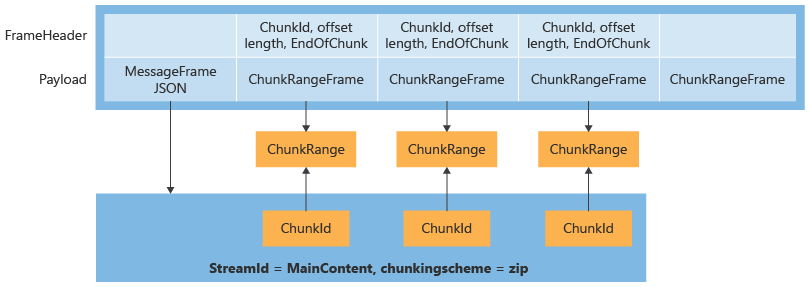Encode and send data on the wire
This article explains how to encode and send data on the wire.
Frame protocol for sending chunks
The request/response payload is broken into frames to send the chunks. Each frame has a header that declares its frame type, extended header size, payload size, and extended header. All binary structures must be provided in big-endian byte order.

Frame type
Four frame types are supported:
MessageJSON– Must be the first frame; contains request or response-body structured data serialized via JSON.Chunk– Contains the full binary content for a given chunk.ChunkIdis stored in the extended header field, and chunk data bytes are stored in the frame payload.- Frame Extended Header – Used for additional data for
ChunkandChunkRangeframes. - Frame Payload – The frame payload is all the data in binary format.
- Frame Extended Header – Used for additional data for
ChunkRange- Contains the partial binary content for a chunk.ChunkId,offset,length, andFlagsare stored in the extended header field, and chunk data bytes are stored in the frame payload.EndFrame– Must be the last frame; indicates the end of the request payload.
The table lists all frame types and expected values for the fields:
| FrameType Name | FrameType | ExtendedHeader Size | Payload Size | Extended Header Contents | Extended Header Encoding | Frame Payload |
|---|---|---|---|---|---|---|
MessageJSON |
2 | 0 | 64-bit integer | Empty | N/A | Structured data applicable to that request or response |
Chunk |
3 | 16 | 64-bit integer | ChunkId (128-bit spooky hash) |
Raw bytes | All chunk data bytes |
ChunkRange |
4 | 36 | 64-bit integer |
|
Raw bytes (all numbers in big-endian byte order) | Chunk range bytes |
EndFrame |
1 | 0 | 0 | Empty | N/A | Empty |
ChunkRange extended header: This data is laid out in bytes as detailed in the preceding table. For the Flags field, these are the only valid values (for the 32-bit unsigned integer) currently:
- 0 - Indicates a
ChunkRangebetween the chunk. - 1 – Indicates the
ChunkRange, which includes the end of the chunk.
Upload request stream example for zip archive file

Upload request stream example for non-zip archive file

Sample PutChunkedFile MessageJSON for a non-zip archive file:
{
"ContentProperties": [],
"Signatures": [
{
"StreamId": "MainContent",
"ChunkingScheme": "FullFile",
"ChunkSignatures": [
{
"ChunkId": "P4oXyRH4V/AHALoD7GZ9Yw==",
"Length": 199999
}
]
},
{
"StreamId": "Alternate",
"ChunkingScheme": "FullFile",
"ChunkSignatures": [
{
"ChunkId": "YKWPmdVdMY14qK003yTMXg==",
"Length": 2999
}
]
}
],
"UploadSessionTokenToCommit": null
}
GetChunks response stream example for zip archive file:

Note
The MessageJSON for all the requests and responses are encoded by using JSON.
Next steps
Learn about Multi-request file uploads.